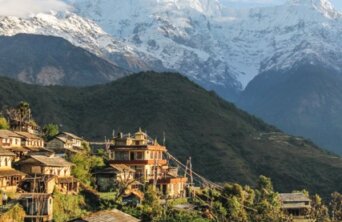- About
- Topics
- Picks
- Audio
- Story
- In-Depth
- Opinion
- News
- Donate
-
Signup for our newsletterOur Editors' Best Picks.Send
Read, Debate: Engage.
| topic: | Climate Change |
|---|---|
| located: | India |
| editor: | Hanan Zaffar |
Frozen water, in its various forms, bears the brunt of climate change. In the mountainous expanse of the Hindu Kush Himalayas (HKH), spanning 3,500 km (2,175 miles) across Afghanistan, Bangladesh, Bhutan, China, India, Myanmar, Nepal, and Pakistan, a noticeable manifestation of climate change is the profound impact on glaciers.
Scientists caution that glaciers in the Hindu Kush Himalayas are melting at unprecedented rates and could lose up to 75 per cent of their volume by the end of the century. This poses a threat of dangerous flooding and water shortages for nearly 2 billion people living downstream along the rivers originating in this mountainous region.
An international team of scientists has observed accelerated ice loss in the region, including the iconic peaks of Everest. The glaciers in the 2010s shed ice at a rate up to 65% faster than the preceding decade, as reported by the Kathmandu-based International Centre for Integrated Mountain Development (ICIMOD), an intergovernmental scientific authority on the region.
The assessment indicates that at a warming of 1.5 degrees Celsius or 2 degrees Celsius above pre-industrial temperatures, glaciers across the entire region could lose 30% to 50% of their volume by 2100. The report underscores the potential for a surge in flash floods and avalanches in the coming years if there is no substantial reduction in greenhouse gas emissions.
Known as "the third pole" due to its status as the Earth's largest concentration of frozen water after the North and South Poles, the Hindu Kush Himalayan region is experiencing a faster rate of warming than the global average. The melting of glaciers in this region since the 1970s has increased exposure of more significant areas to solar radiation, resulting in greater heat absorption. Unlike the Arctic, debris cover on many glaciers in the HKH region somewhat mitigates this effect.
The consequences of melting glaciers extend beyond the immediate region, posing a threat to the 240 million people residing in the Himalayan area and an additional 1.65 billion people living downstream in the 12 river basins, including the Ganges, Indus, and Mekong, originating in these mountains.
India, in particular, faces environmental challenges in the Gangetic basin, where water supply depends on melting snow and glacier ice. Increased variability in precipitation outweighs short-term benefits from glacier melt runoff, heightening flood risks in water supply shifts. The retreat of glaciers and snow will lead to the loss of crucial local springs and streams in many semi-arid mountain areas, vital for villages and livestock grazing.
Addressing this crisis requires a concerted effort to foster regional cooperation in quantifying effects, assessing vulnerability, and combating climate change impacts on glacial ecosystems through mitigation and adaptation measures. The world must prioritise the reduction of carbon emissions.
The HKH Assessment advocates for expanding observation networks and data-sharing agreements across the extended HKH region, coupled with advancements in research and observation, to predict and minimise the impact of disasters and avalanches.
Image by Giuseppe Mondì.

